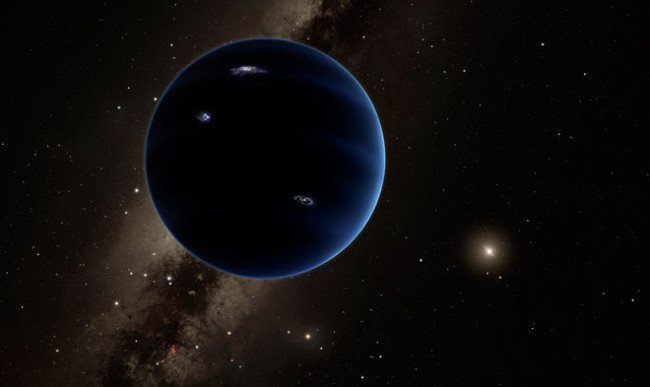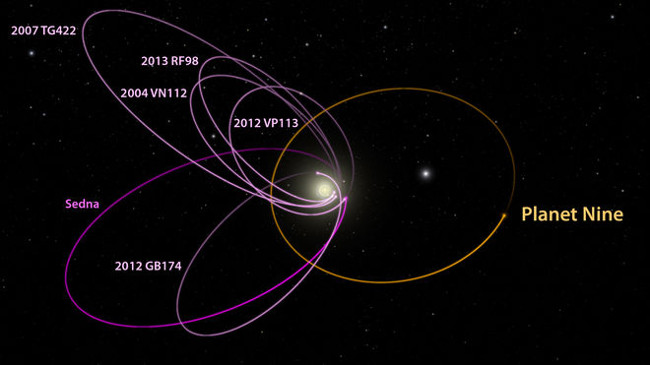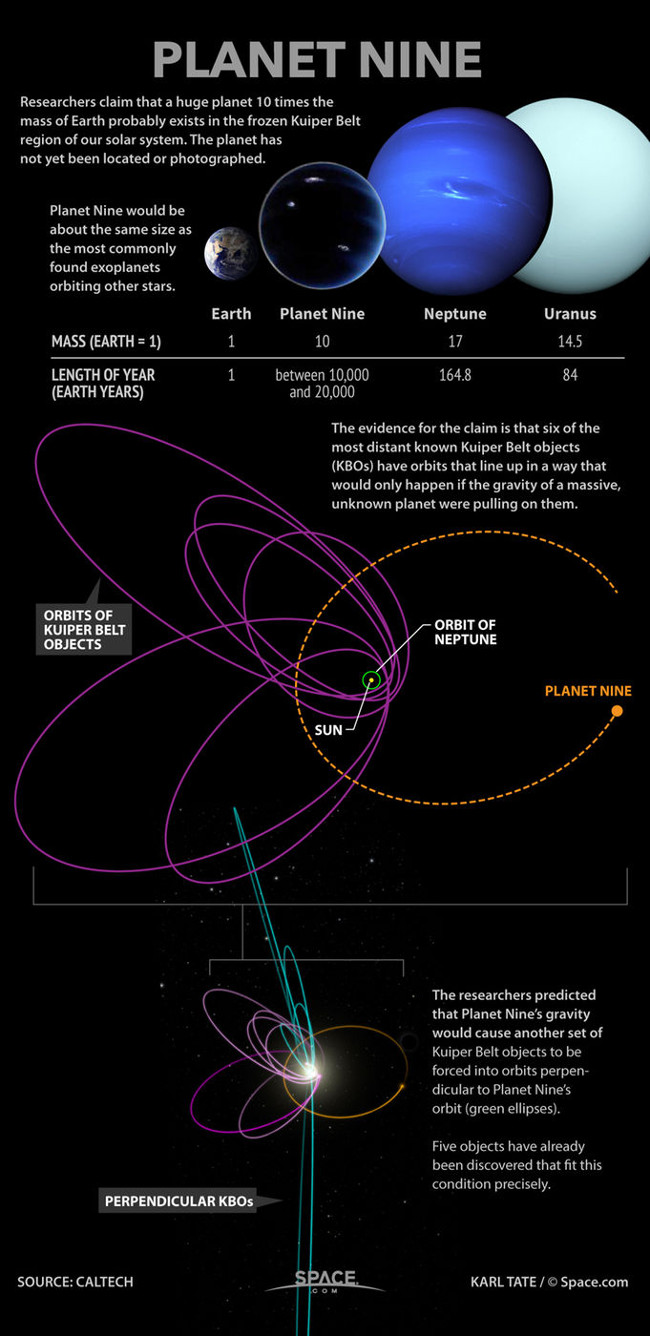Photos of the 9th planet in our solar system
Recently, on October 20, scientists around the world announced that they had discovered a potential "9th planet" in our solar system. This mysterious giant planet is said to have 10 times the mass of Earth, but the exact location is unknown. However, the image of this giant, exotic planet shows that it is a " neighbor " planet to our Earth. [ 10 interesting facts about the Earth you may not know yet ]
 Photos depicting the 9th planet of scientists.Photo source: Caltech / R. Hurt (IPAC)
Photos depicting the 9th planet of scientists.Photo source: Caltech / R. Hurt (IPAC)
Evidence of the 9th planet shows that it is a giant planet , 10 times more massive than the planet Earth deep in the Kuiper belt. The orbit of the 9th planet is 20 times larger than the distance from the Sun to Neptune.
 Photo taken at the edge of the solar system.Photo source: Caltech / R. Hurt (IPAC)
Photo taken at the edge of the solar system.Photo source: Caltech / R. Hurt (IPAC)
Caltech scientist Mike Brown (on the left, a strange object hunter in the Kuiper belt) and Konstantin Batygin gave proof of the ninth planet. The duo used mathematical models and simulations on the computer to map the 9th planet's orbit after the strange connection in the trajectory of 6 different objects in the Kuiper belt. [Space science: The order of 8 (or 9) inner planets Solar system]
 Two scientists discovered the ninth planet. Image source: Lance Hayashida / Caltech
Two scientists discovered the ninth planet. Image source: Lance Hayashida / Caltech
Here's all we know about the ninth planet. The researchers claim: " A giant planet 10 times the weight of the planet Earth is located in the Kuiper belt in the solar system. The ninth planet has no known location, the ninth planet is about the same size as the outer planets orbiting stars, and the evidence shows that the distance between the six objects on the Kuiper belt is known. with orbit is a straight line, this can only happen if a giant, unidentified planet will pull them ".
Researchers predict: " The gravity of the 9th planet may be the cause of the Kuiper belt object group being pulled into orbit perpendicular to the orbit of the 9th planet (blue elliptical path). 5 previously discovered objects will soon adapt to this . "
 Photo source: Graphic designer - Karl Tate.
Photo source: Graphic designer - Karl Tate.
If a planet is 10 times more massive than the Earth, orbits the Sun and is farther away than Neptune, it will affect the trajectory of objects near it. "The five objects identified will soon match the predicted orbit (as shown in the figure below), " the researchers said.
 Photo source: Caltech / R. Hurt (IPAC)
Photo source: Caltech / R. Hurt (IPAC)
You should read it
- Discover the strange green planet HD 189733b outside the solar system
- Discovering the planet has an orbit of 4.5 hours, where people can live 150,000 years
- How hot is the planet of Mercury?
- Space Science: The order of 8 (or 9) planets in the Solar System
- NASA declares the existence of the 9th planet in our Solar System
- The discovery of the 'Second Earth' can exist only 4.2 light-years away from Earth
- The distance from Earth to Jupiter - what is the largest planet of the solar system?
- The surface of Venus: Why is Venus the hottest planet in the solar system?
May be interested
- When can we determine the position of the '9th planet' in the solar system?
 the hidden days of the ninth planet are not observed while in the dark depths outside the solar system that can be counted. so when can we determine the position of the 9th planet in the solar system?
the hidden days of the ninth planet are not observed while in the dark depths outside the solar system that can be counted. so when can we determine the position of the 9th planet in the solar system? - Comet 67P is cracked and may crumble in the future
 a series of strange signs such as cracks that were found on the comet surface of comet 67p made the scientific community extremely shocked.
a series of strange signs such as cracks that were found on the comet surface of comet 67p made the scientific community extremely shocked. - Finding strange objects with 'Niku' poses a great challenge to scientists
 a mysterious object that lies in the outer ring of the solar system revolves around the sun in a strange way that scientists have not yet explained why.
a mysterious object that lies in the outer ring of the solar system revolves around the sun in a strange way that scientists have not yet explained why. - New research confirms: The mystery of 'dark energy' may not exist
 the universe may not expand at an accelerated rate after that, meaning that the dark energy mystery may not really exist, according to a new study.
the universe may not expand at an accelerated rate after that, meaning that the dark energy mystery may not really exist, according to a new study. - The most intense battle in the history of the Milky Way was recorded
 after years of studying the universe, scientists have for the first time published images of the battle that is considered to be the most fierce in our milky way.
after years of studying the universe, scientists have for the first time published images of the battle that is considered to be the most fierce in our milky way. - Cosmic science: Inclined planets around small stars can hardly survive life
 there are many traits that can make a planet difficult to survive, a new study suggests that: for some planets, tilting orbits can be one of those factors.
there are many traits that can make a planet difficult to survive, a new study suggests that: for some planets, tilting orbits can be one of those factors.






 NASA declares the existence of the 9th planet in our Solar System
NASA declares the existence of the 9th planet in our Solar System When can we determine the position of the '9th planet' in the solar system?
When can we determine the position of the '9th planet' in the solar system? The deviating object in the Kuiper Belt may be the 10th planet of the solar system
The deviating object in the Kuiper Belt may be the 10th planet of the solar system If 'stray' to any planet in the solar system, what is your chance of survival?
If 'stray' to any planet in the solar system, what is your chance of survival? The surface of Venus: Why is Venus the hottest planet in the solar system?
The surface of Venus: Why is Venus the hottest planet in the solar system?